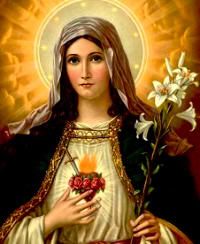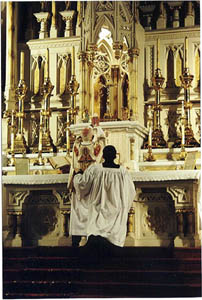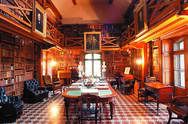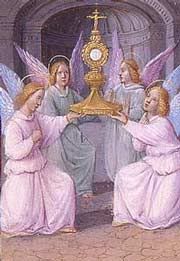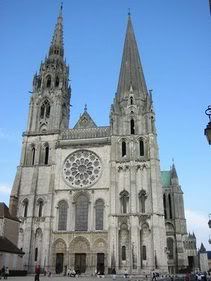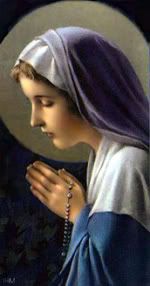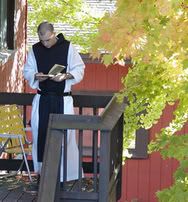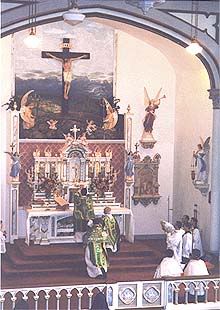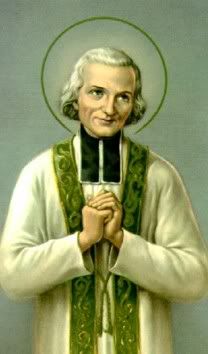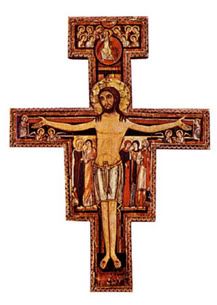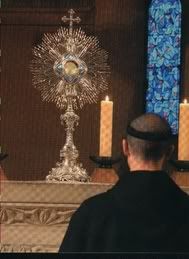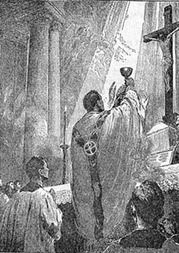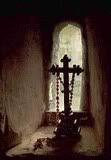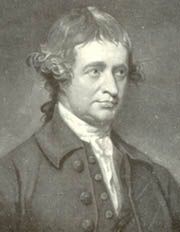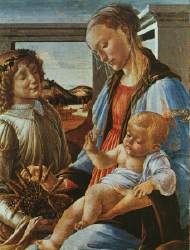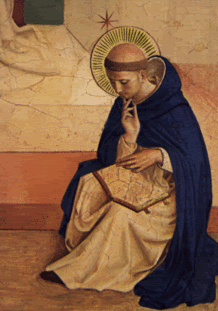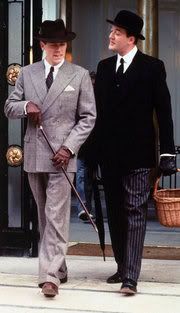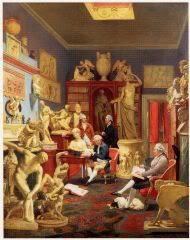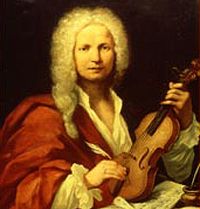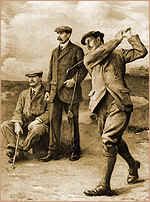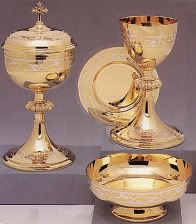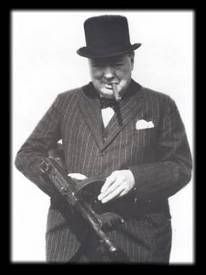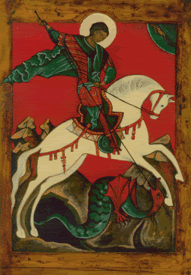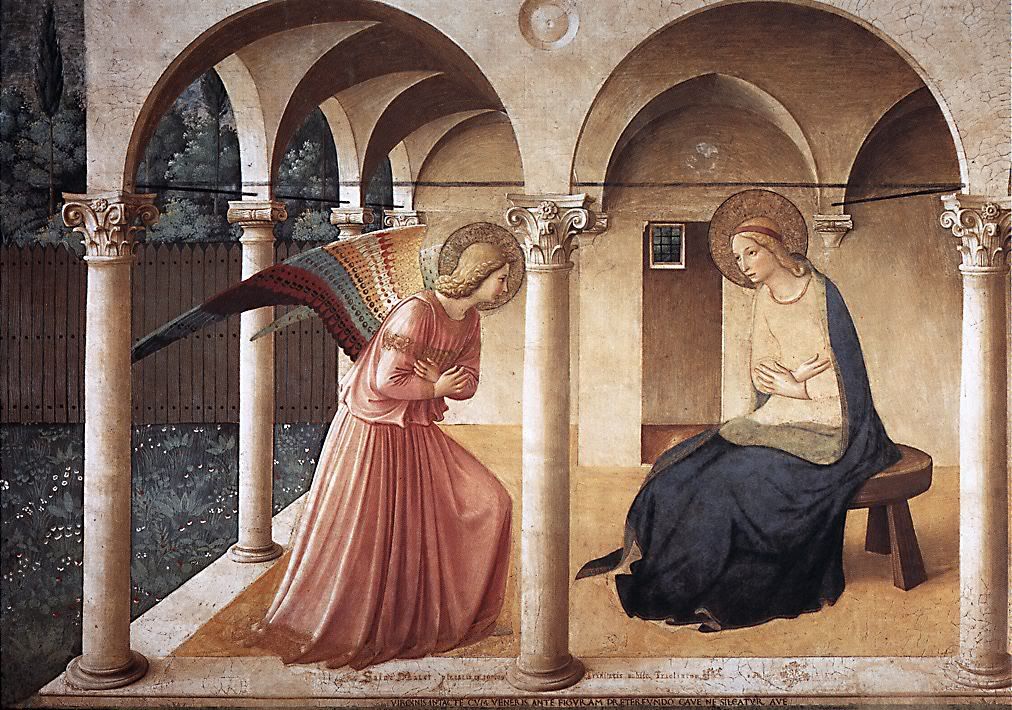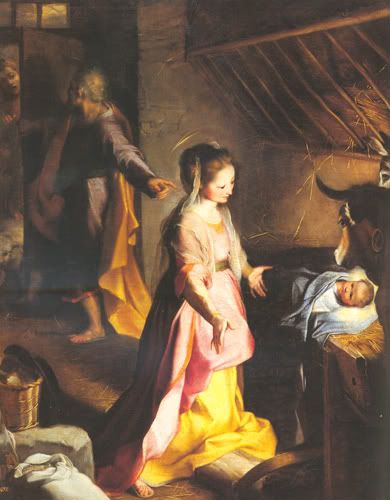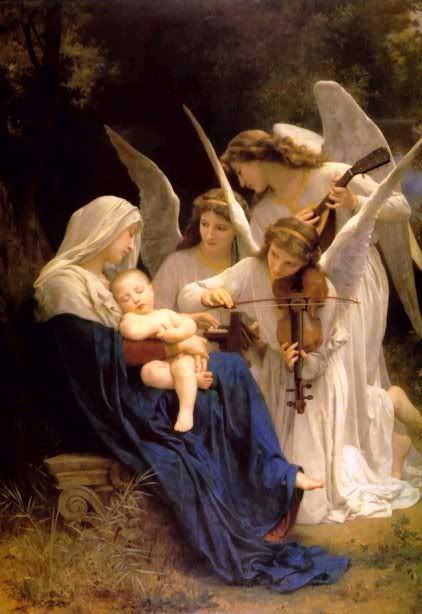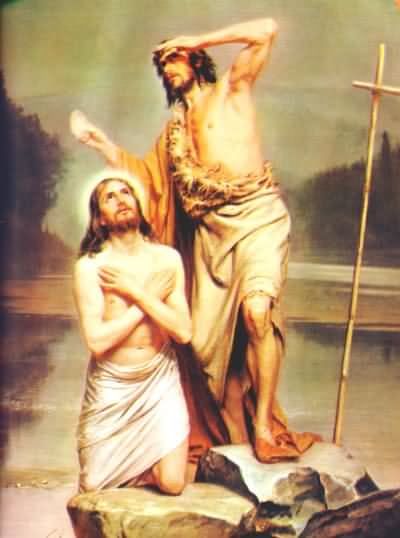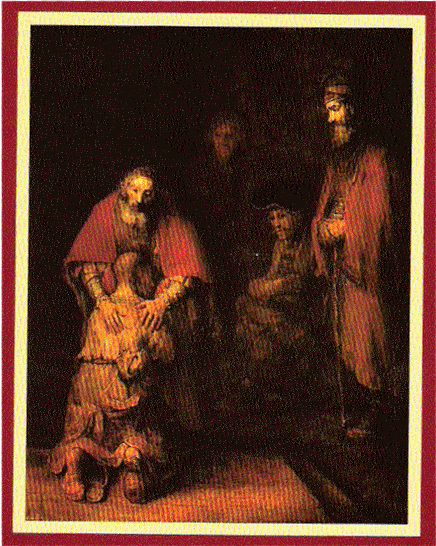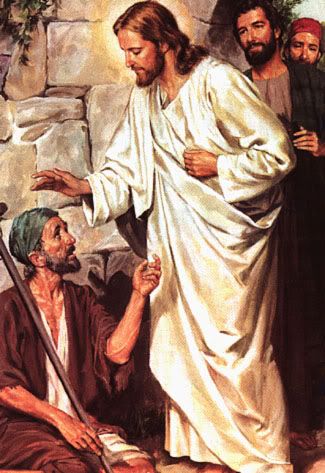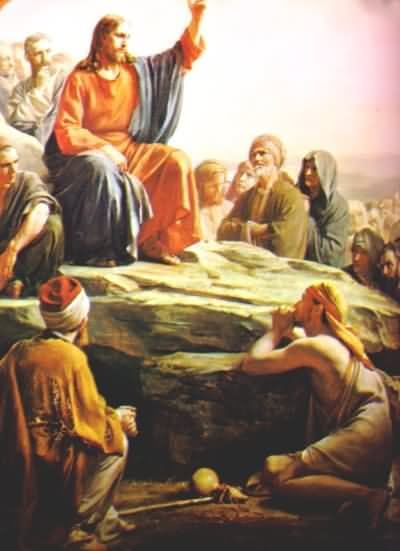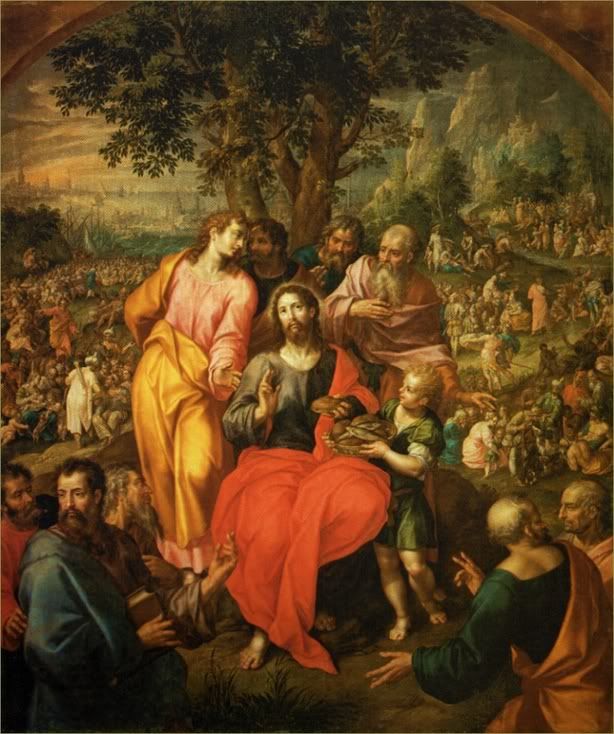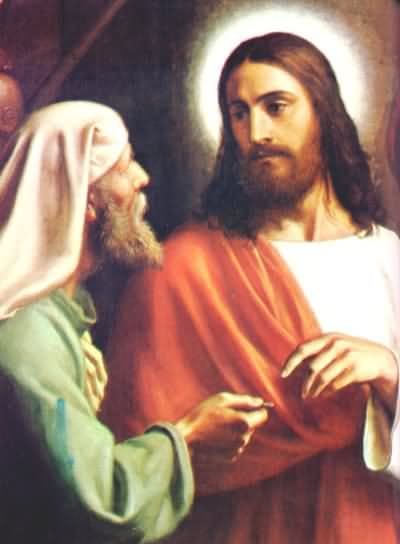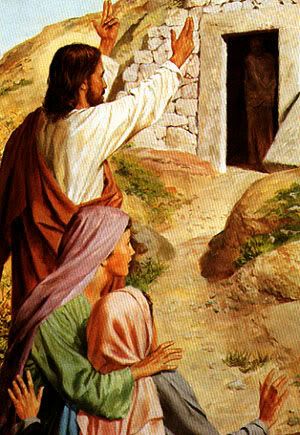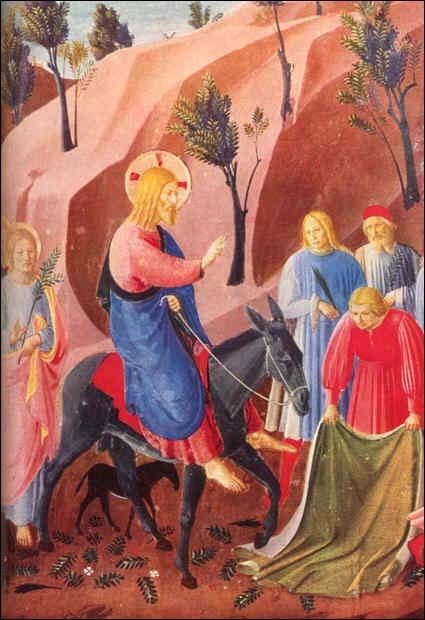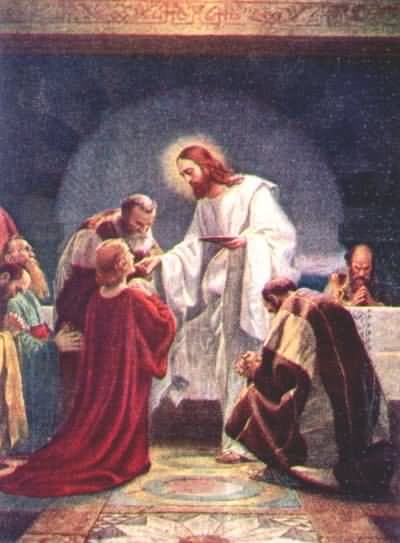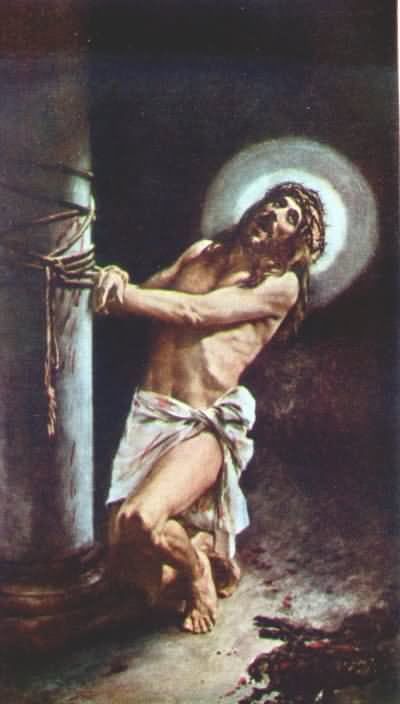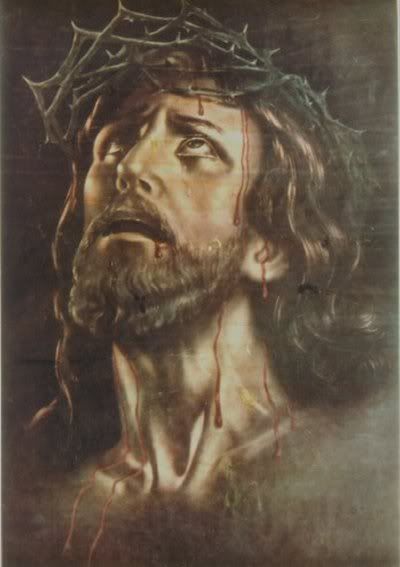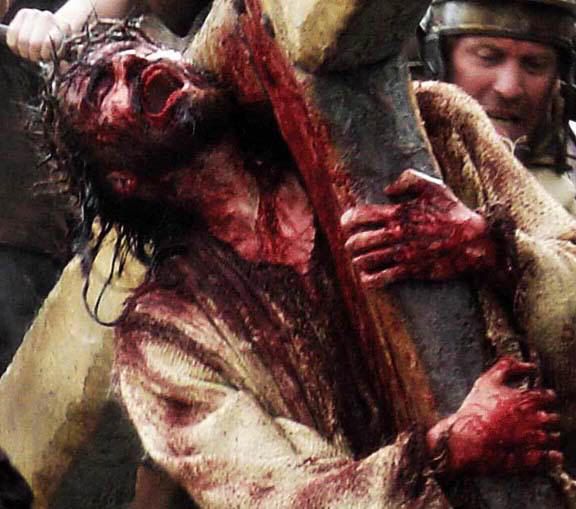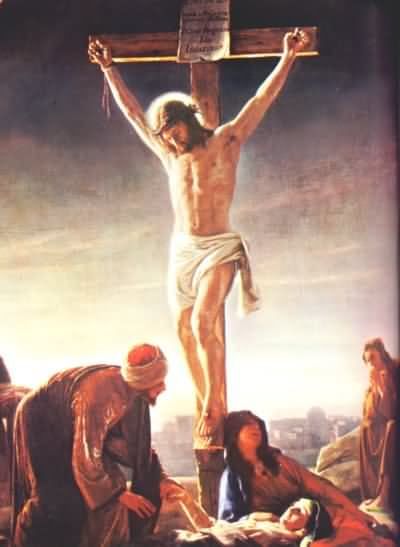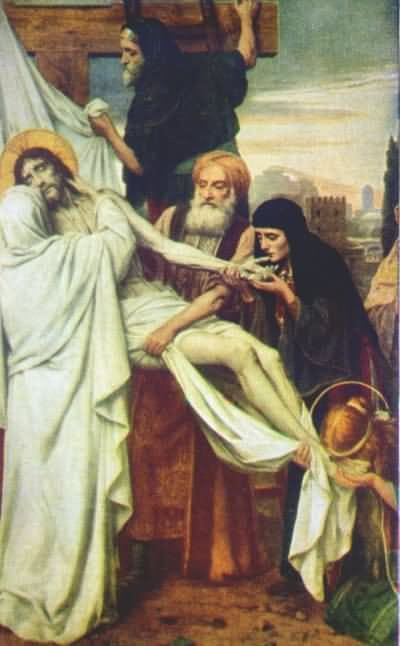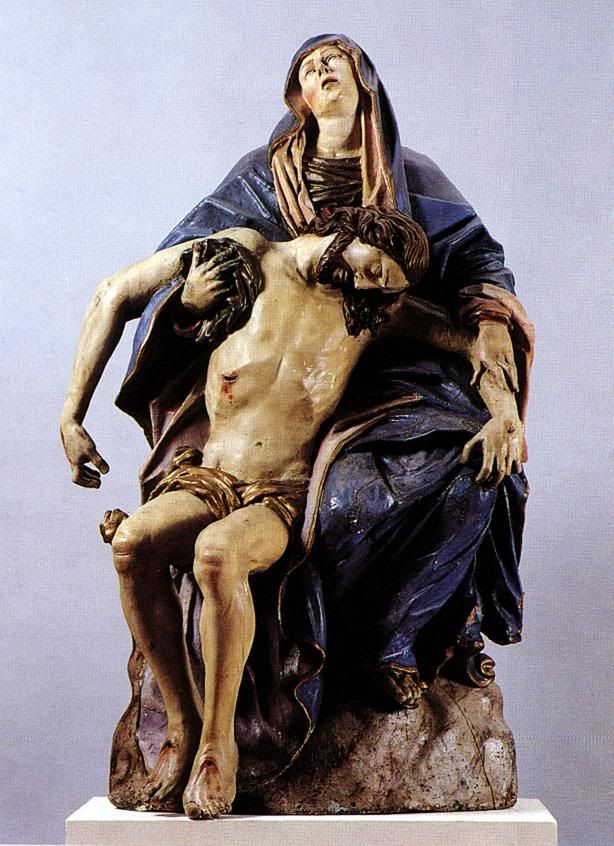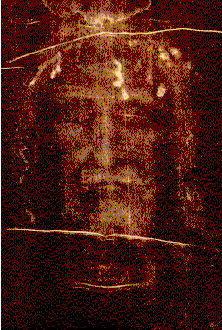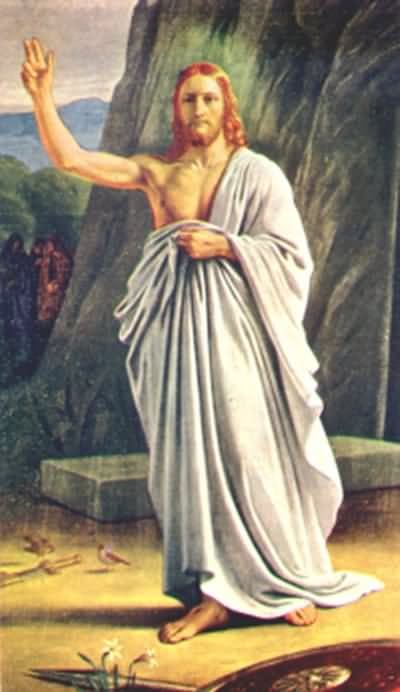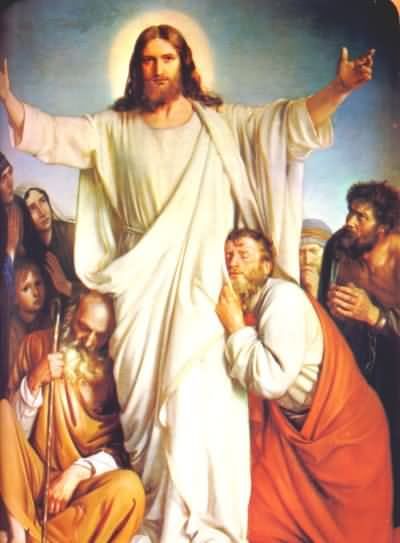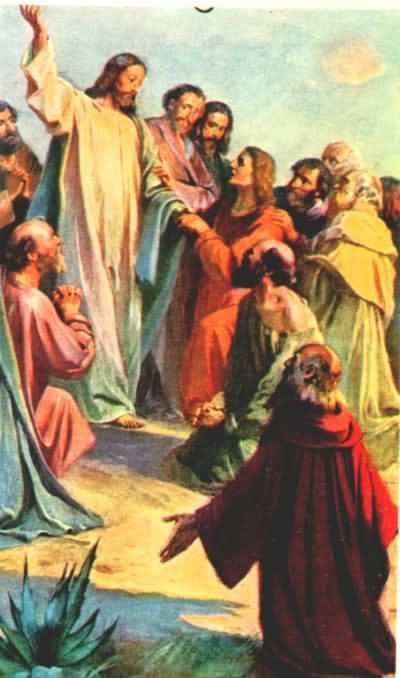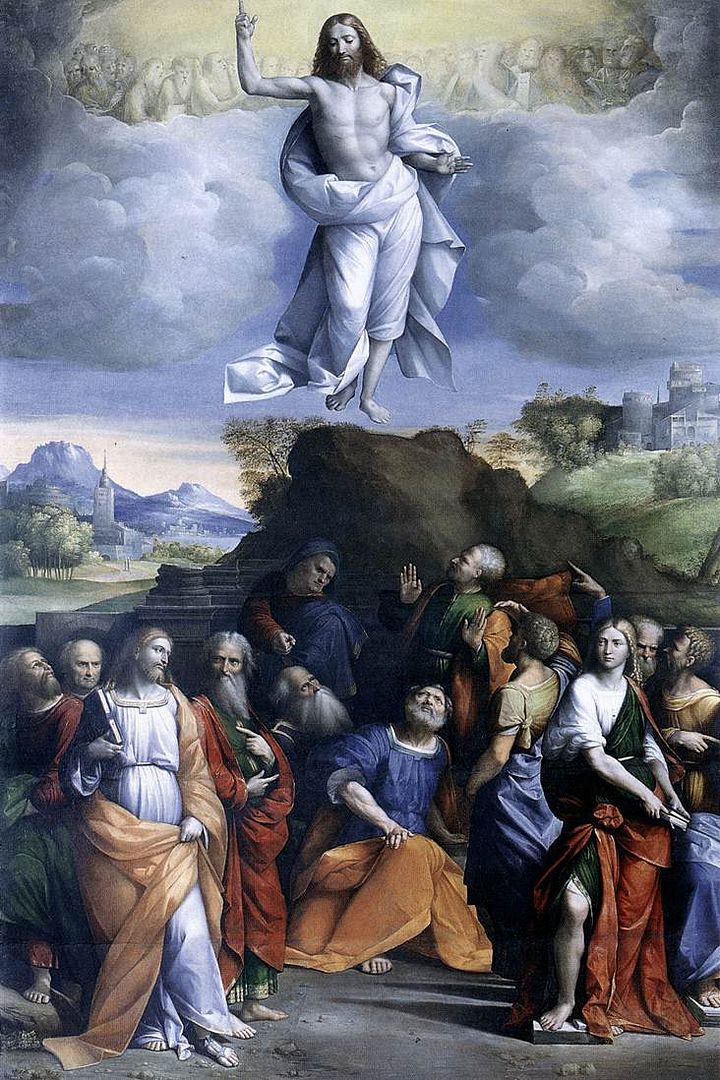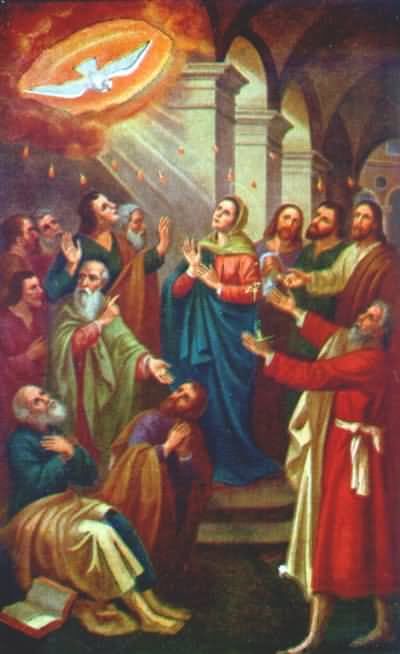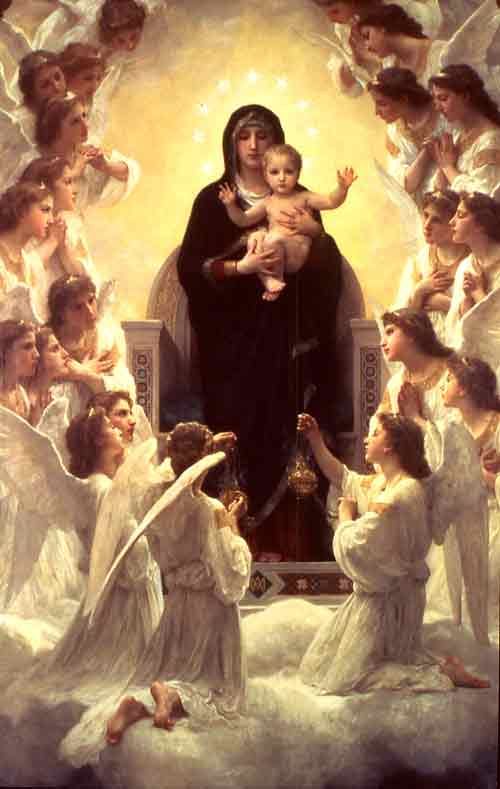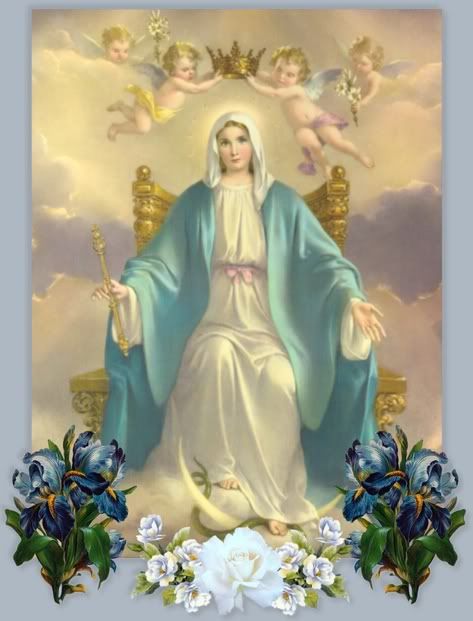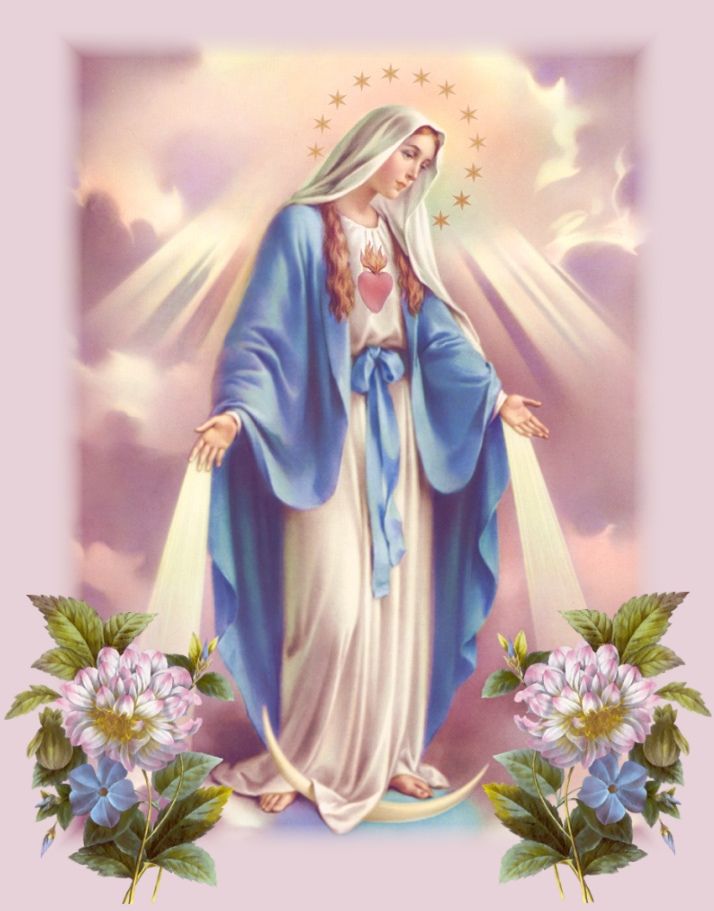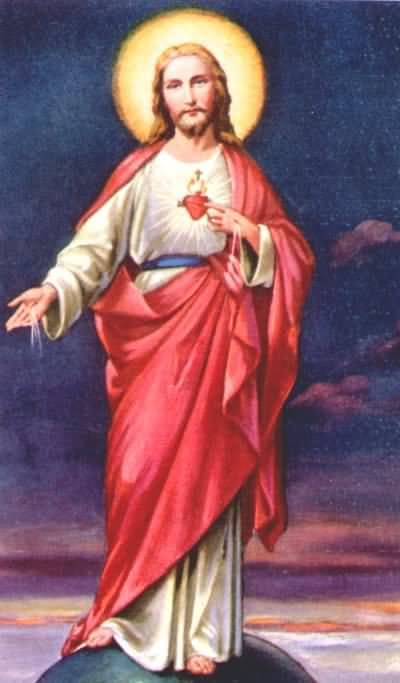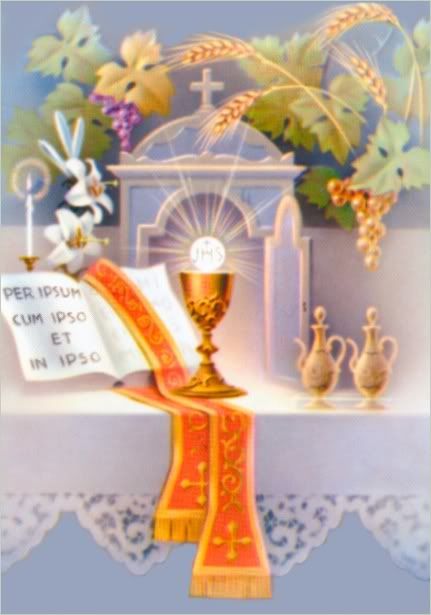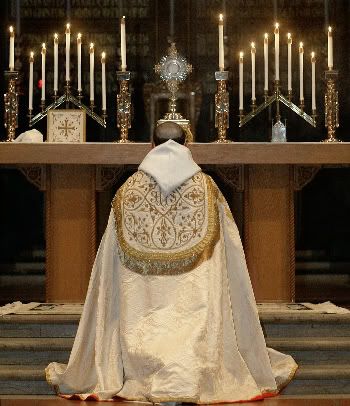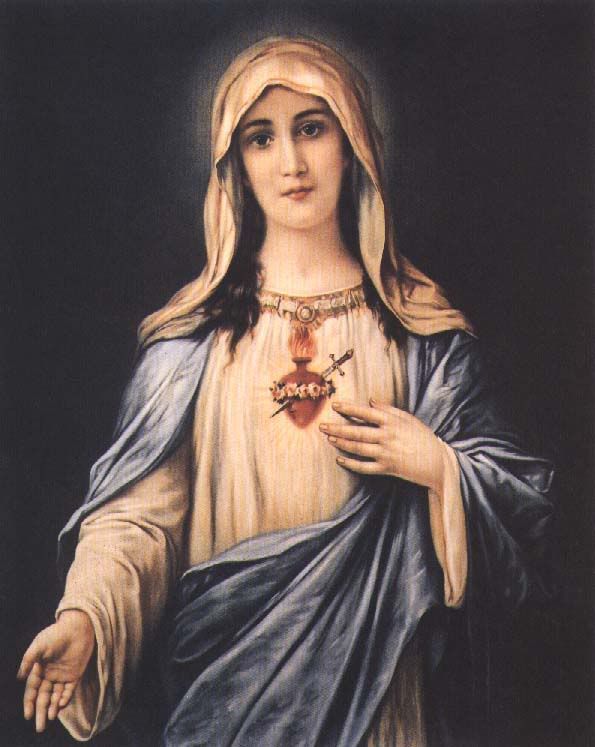Saturday, May 26, 2007
Daily Prayer During Our Blessed Lady's Month
Late with this one and Sunday's. Sorry about that. I'm always playing catch-up on holiday weekends.

From The Glories Of Mary, by Saint Alphonsus Liguori:
Most Holy, Immaculate Virgin and my Mother Mary! To thou who art the Mother of my Lord, the Queen of the world, the Advocate, the Hope, and the Refuge of sinners, I have recourse today, I who am the most miserable of all.
I render thee my most humble homage, O great Queen, and I thank thee for all the graces thou hast conferred on me until now, especially for having delivered me from Hell, which I have so often deserved.
I love thee, O most amiable Lady; and for the love which I bear thee, I promise to serve thee always and to do all in my power to make others love thee also. I place in thee all my hopes; I confide my salvation to thy care.
Accept me for thy servant and receive me under thy mantle, O Mother of Mercy. And since thou art so powerful with God, deliver me from all temptations; or rather, obtain for me the strength to triumph over them until death. Of thee I ask a perfect love for Jesus Christ.
Through thee I hope to die a good death. O my Mother, by the love which thou bearest to God, I beseech thee to help me at all times, but especially at the last moment of my life. Leave me not, I beseech thee, until thou seest me safe in Heaven, blessing thee and singing thy mercies for all eternity.
Amen.
Thus, I hope.
Thus, may it be.

From The Glories Of Mary, by Saint Alphonsus Liguori:
Most Holy, Immaculate Virgin and my Mother Mary! To thou who art the Mother of my Lord, the Queen of the world, the Advocate, the Hope, and the Refuge of sinners, I have recourse today, I who am the most miserable of all.
I render thee my most humble homage, O great Queen, and I thank thee for all the graces thou hast conferred on me until now, especially for having delivered me from Hell, which I have so often deserved.
I love thee, O most amiable Lady; and for the love which I bear thee, I promise to serve thee always and to do all in my power to make others love thee also. I place in thee all my hopes; I confide my salvation to thy care.
Accept me for thy servant and receive me under thy mantle, O Mother of Mercy. And since thou art so powerful with God, deliver me from all temptations; or rather, obtain for me the strength to triumph over them until death. Of thee I ask a perfect love for Jesus Christ.
Through thee I hope to die a good death. O my Mother, by the love which thou bearest to God, I beseech thee to help me at all times, but especially at the last moment of my life. Leave me not, I beseech thee, until thou seest me safe in Heaven, blessing thee and singing thy mercies for all eternity.
Amen.
Thus, I hope.
Thus, may it be.
Labels: Restorationists
Friday, May 25, 2007
Check This Out
Latin Novus Ordo Mass In Boston
I have long suspected that the Oblates of the Virgin Mary at St. Clement's Eucharistic shrine offer a Novus Ordo Mass in Latin, since it is the oratory for their seminary. One day, coming in for Eucharistic adoration in the afternoon, I happened upon some music sheets that implied that such a Mass had been offered there that morning. Now, thanks to some digging by one of the members of Boston's indult Mass community at MIL Tridentine Yahoo Group, I was able to confirm that such a Mass is offered, at 7am at St. Clement's every Tuesday and Thursday. They are on hiatus now until the fall, when classes resume at the seminary.
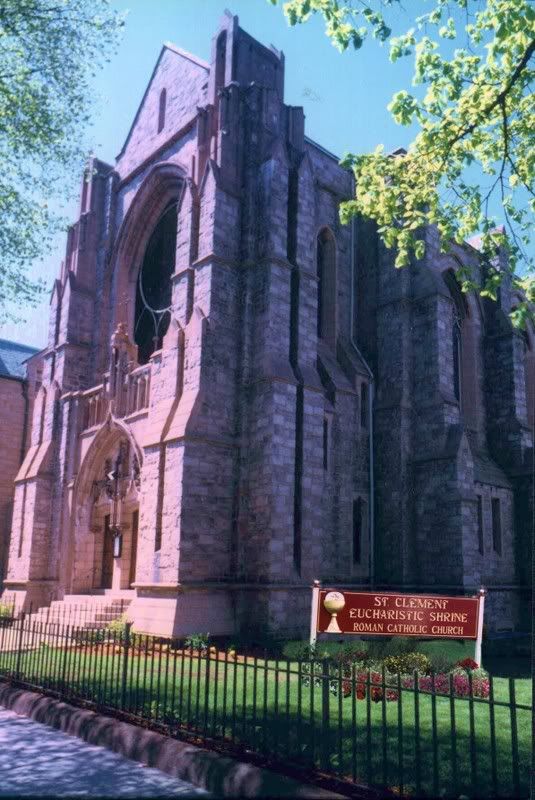
Spoke to Fr Dan Barron today, who Celebrates the Tues and Thurs
morning Masses at St Clement's (7:00am). Turns out that St Clements
HAS been doing a Latin Mass (N.O.) every Tuesday and Thursday since
the beginning of the year, in response to the Pope's letter to
Seminaries. Since every seminarian is to be taught Latin and the
various forms of the Roman Rite, and St Clement is attached to a
Seminary, they immediately instituted this Mass on hearing from Rome.
No details on the reaction of the RCAB, but can't imagine any
legitimate objection, since this has ALWAYS been allowed without
restriction. ;). It is presently on hiatus but WILL start again in the
fall. No word on what will transpire should the Motu Proprio come out
before then, in the meantime, this notice on a sung (N.O.) Latin Mass
this Friday at St Francis Chapel.
Just a friendly invitation to a special Mass at 7pm this Friday.
A sung Latin Mass will be celebrated at St. Francis Chapel in
honor of Venerable Pio Bruno Lanteri on the occasion of the 225th
anniversary of his ordination to the priesthood.
Date and Time: Friday, May 25th, 7:00 PM at St. Francis Chapel in
the Prudential Center

The OMV staff and run both St. Francis Chapel in the Pru and St.
Clement Shrine on Boylston St. They tirelessly work to serve the
larger community, celebrating Masses, hearing confessions, leading
retreats, and giving spiritual direction. Their seminary is also
located adjacent to the Shrine - please do keep their seminarians in
your prayers.
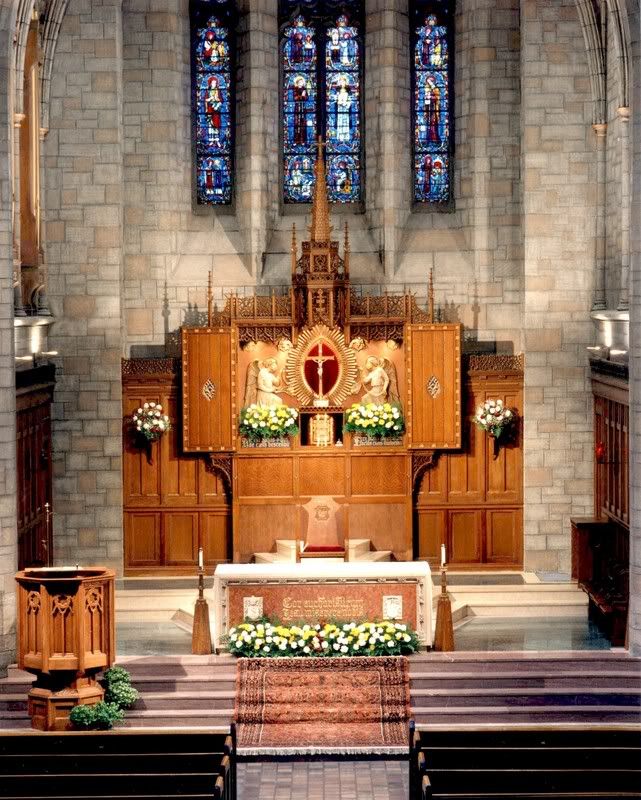


Spoke to Fr Dan Barron today, who Celebrates the Tues and Thurs
morning Masses at St Clement's (7:00am). Turns out that St Clements
HAS been doing a Latin Mass (N.O.) every Tuesday and Thursday since
the beginning of the year, in response to the Pope's letter to
Seminaries. Since every seminarian is to be taught Latin and the
various forms of the Roman Rite, and St Clement is attached to a
Seminary, they immediately instituted this Mass on hearing from Rome.
No details on the reaction of the RCAB, but can't imagine any
legitimate objection, since this has ALWAYS been allowed without
restriction. ;). It is presently on hiatus but WILL start again in the
fall. No word on what will transpire should the Motu Proprio come out
before then, in the meantime, this notice on a sung (N.O.) Latin Mass
this Friday at St Francis Chapel.
Just a friendly invitation to a special Mass at 7pm this Friday.
A sung Latin Mass will be celebrated at St. Francis Chapel in
honor of Venerable Pio Bruno Lanteri on the occasion of the 225th
anniversary of his ordination to the priesthood.
Date and Time: Friday, May 25th, 7:00 PM at St. Francis Chapel in
the Prudential Center

The OMV staff and run both St. Francis Chapel in the Pru and St.
Clement Shrine on Boylston St. They tirelessly work to serve the
larger community, celebrating Masses, hearing confessions, leading
retreats, and giving spiritual direction. Their seminary is also
located adjacent to the Shrine - please do keep their seminarians in
your prayers.


Labels: Restorationists
Vibrant Parish Life
Ann Taves' secular history, The Household of Faith (University of Notre Dame Press, Notre Dame, IN, 1986) I found last year to be a very good source of information on 19th century Catholic devotional life in the US. Most of us are coming to the Faith with only the experience of the 1970s-1990s behind us. We were deprived of the wealth of traditional Catholic practice and Catholic life, in the cause of getting Catholics out of the "Catholic Ghetto."
Here is her redaction of a parish history from Chicago (Holy Name parish, which still exists).
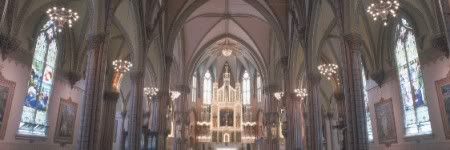
This excerpt is located at pp. 120-125 of The Household Of Faith. I reprint it in full because I think this description might open up eyes regarding what a Catholic Restoration might entail, and the kind of framework in which it can thrive.
The impact of devotionalism on the life of the parish church can be illustrated by the example of Holy Family parish on Chicago's west side. Founded in 1857 by the Jesuit Arnold Damen, it soon boasted the largest English-speaking congregation in the city and one of the largest and most elaborate parish complexes int he nation. Moreover, several of the church;s priest, most notably Fathers Damen and Cornelius Smarius, were among the leading mission preachers of the day; they thus spent much of their time attempting to arouse and institutionalize the type of piety evident at Holy Family parish in churches run by secular clergy throughout the midwest. As an illustration, Holy Family church is therefore probably not entirely typical. However, since the parish served as a model for other churches in its own time, it may be taken to reflect an ideal, whether or not all parishes were able to live up to it.
According to Brother Thomas Mulkerins, S.J., the parish historian, Father Damen began introducing devotional practices and founding devotional organizations among his parishioners shortly after a plain, wooden temporary church building was erected in 1857. In November of 1857, the first of what were to become annual novenas in preparation for the Feast of the Immaculate Conception was celebrated. During the first lenten season after the church's establishment, Damen celebrated Mass daily, "followed by a meditation read to the people, the rosary, instructions and benediction on Wednesday, and Stations of the Cross on Friday evening." On the first of May 1858, "the fathers began the beautiful May devotions in honor of Our Lady. These were held every evening at eight o'clock, and took such hold upon the people as to mark an increased attendance every year." In October of 1858, the parish held its first mission week and beginning a few weeks later, "the devotions to the souls in Purgatory, during the month of November, were practiced for the first time in the parish."
During the same period, Damen also founded the Archconfraternity of the Immaculate heart of Mary, the Altar Society, the Society of St. Vincent dePaul, and the Society of the Hoily Family for Men 9later to become the Married Men's Sodality). At the same time, Damen oversaw an ambitious building program. Following the construction of the wooden frame church, a residence was built for the priests, then a school, and by the summer of 1860, a permanent Gothic church built of stone. Despite this feverish building campaign, "Father Damen and his associates," according to Mulkerins, "never lost sight of the spiritual end, which was the motive power of all their actions." Significantly, Mulkerins defines this spiritual end in devotional terms. Specifically, he says that "the spiritual end is seen in the regular ministrations and in the various devotions introduced, the novenas, the confraternities, and the sodalities, the courses of lectures and instructions, the Lenten, May, and November devotions, the solicitude for the poor, the orphans, and the outcast."
Although the exterior of the new Gothic building was not, in Mulkerin's words, "very attractive and prepossessing," the interior of the church, acclaimed by many as "one of the most beautiful...in the United States," embodied the devotional style which had been introduced into the old church.
The church contained three altars, a main altar and two side altars. The main altar stretched the width of the church and extended upward fifty-two feet, to within inches of the ceiling. Nearly everything atop the main altar was designed to foster devotion to the Blessed Sacrament and the passion. Above it was a large Gothic tabernacle with angels on either side in which consecrated hosts were stored. The "benediction throne" on which the host could be displayed was attached to the "roof" of the lower part of the tabernacle.
The main altar also contained four "cases" of sacred relics. According to Mulkerins, some of these were, "very precious, as they contained fragments of the bones or other sacred objects belonging to apostles and martyrs--one especially, that of the Holy Cross, contained some relics of the instruments of the passion, and was put on exhibition on Good Friday." Statues of the Sacred heart, Saint Anne, and Saint Joseph were also located on the main latar with "lights burning daily before them."
The two permanent side altars were dedicated to the Virgin Mary and St. Joseph. Both were constructed "on the same lines as the main altar, and reached from the floor of the sanctuary to the ceiling." According to Mulkerins, each had three Gothic turrets, two smaller ones on the sides and the main one on top. The side altar dedicated to the Virgin contained a large statue of Our Lady of Lourdes flanked by two smaller statues of Saint Aloysius and Saint John Berchmans. A picture of the Immaculate Conception hung nearby. The statue of Our Lady of Lourdes was the focus of May devotions in the new church. during May, the "little statue..., noted for its devotional beauty,...was taken down from its niche on the top of the altar and placed in the beautiful shrine prepared for it." The side altar dedicated to Saint Joseph contained two pictures, one of Saint Charles Borromeo administering holy communion to Saint Aloysius, and of Saint Joseph holding the child Jesus. Statues of Saint Aloysuis and Saint Stanislaus were located on either side of the base of the altar.
Mulkerins reported that in 1873, "new Stations of the Cross were erected." These stations, imported from Europe, were eight feet high and six feet wide. Mulkerins stressed the realistic character of the paintings, with their almost life-sized figures each standing out "as if the life blood was coursing through the body." A few other devotions and a variety of new devotional societies were introduced once the congregation moved into the new church. New devotions included devotions to the Sacred Heart of Jesus, an annual solemn novena "in honor of the patronage of Saint joseph<" and the forty hours' devotion, which was introduced in 1876.
According to Mulkerins, "the first great mission ever held in Holy Family Parish was begun[in August 1861], and continued for two weeks." Mission exercises included Mass and instruction at five in the morning; Mass and a sermon at eight in the morning; the way of the cross and instruction in the afternoon; and the rosary, a sermon, and benediction of the Blessed Sacrament in the evening.
Another mission was held in 1869 which was "thought by some to be, perhaps, the greatest mission ever given in Holy Family Church." According to Mulkerins, "Fathers Damen, Smarius, Masselis, Coghlan, and Verdin [from Holy Family parish] all took par,t and at least two of these, Fatherd Damen and Smarius, were undoubtably the greatest missionaries in the United States during their day."
New organizations founded in the new church included an Acolytical Society for boys in 1860, the Association of the Sacred Heart, the Holy Rosary Society, the Young Ladies' Sodality, the Holy Angels' Sodality, and the Society of the Living Rosary in 1861; Saint Ann's Sodality for married women and the Married Men's Band in 1862; the Purgatorial society and the Apostleship of Prayer in 1864; the Sodality of the Annunciation in 1868; the Bona Mors Society and the Young Men's Sodality in 1869; and the Catholic Total Abstinence and Benevolent Society in 1870.
Although mid-nineteenth century American priests spent an enormous amount of time raising money and overseeing the construction of new churches and schools, their obsession with building, viewed from a devotional angle, reflected the immigrant Catholics' desire to create a distinctively Catholic space. For the Romanized Catholic, the parish church was the center of that Catholic space, and within the church, the altar with its tabernacle containing the Blessed Sacrament was the center of attention. But the side altars, votive candles, the stained glass, the stations of the cross, and the dim light, all contributed to the creation of a distinctively Catholic interior as well.
A man who had grown up in Holy Family parish captured something of the impact of the church's interior. Returning some years later, he said:
I noted the seven lights still burning before he statue of the Blessed Virgin Mary, lighted in 1871 by Father Damen, and to be kept forever burning in her honor in thanksgiving for the preservation of the church and the parish from the ravages of the great fire that all but consumed Chicago. The fine old Stations of the Cross still ornament and glorify the walls looking more than ever like old masters. The same majestic altar, the sturdy pews, the roomy confessionals and the strikingly beautiful altar rail, both masterpieces of the wood carver's art, the galaxy of saints and martyrs and confessors all about on their carven pedestals and the soft light filtering through the [stained glass] windows selected and executed with erudition and devotion, all conjure up feelings and emotions as i experience nowhere else--as if it were nearer Heaven here than elsewhere.
The interior design of the church was intended to conjure up exactly the sort of feelings this returning parishioner described. Catholics were taught that Jesus was present on the altar, that Jesus, Mary, and the saints did respond to prayer, and that graces and favors were more readily available in the church than elsewhere. The devotional artifacts within the church helped to create the sense that one was in a sacred space where familiar intercourse between this word and the other world could take place.
The luxuriant growth of devotional organizations both protected, defined, and directed attention toward this sacred space. In the words of one nineteenth century prelate, such organizations were designed "to create artificially environments in which the supernatural life could develop freely." While church buildings created a material space for interacting with the supernatural, devotional organizations created a social space in which such activities could be taken for granted. These organizations, the primary arena for intensified adult lay involvement in the church at that time, thus helped maintain the subjective reality of that other, supernatural world with which Catholics communicated through prayer.
Although devotional organizations were at the center of parish life, they wee surrounded by a growing network of organizations (mutual benefit, temperance, and charity) and institutions (schools, hospitals, orphanages, and cemeteries)that radiated outward from the church. This growing network of associations and institutions permitted and encouraged Catholics to remain within the confines of the group for all their primary relationships throughout the various stages of their lives.
Here is her redaction of a parish history from Chicago (Holy Name parish, which still exists).

This excerpt is located at pp. 120-125 of The Household Of Faith. I reprint it in full because I think this description might open up eyes regarding what a Catholic Restoration might entail, and the kind of framework in which it can thrive.
The impact of devotionalism on the life of the parish church can be illustrated by the example of Holy Family parish on Chicago's west side. Founded in 1857 by the Jesuit Arnold Damen, it soon boasted the largest English-speaking congregation in the city and one of the largest and most elaborate parish complexes int he nation. Moreover, several of the church;s priest, most notably Fathers Damen and Cornelius Smarius, were among the leading mission preachers of the day; they thus spent much of their time attempting to arouse and institutionalize the type of piety evident at Holy Family parish in churches run by secular clergy throughout the midwest. As an illustration, Holy Family church is therefore probably not entirely typical. However, since the parish served as a model for other churches in its own time, it may be taken to reflect an ideal, whether or not all parishes were able to live up to it.
According to Brother Thomas Mulkerins, S.J., the parish historian, Father Damen began introducing devotional practices and founding devotional organizations among his parishioners shortly after a plain, wooden temporary church building was erected in 1857. In November of 1857, the first of what were to become annual novenas in preparation for the Feast of the Immaculate Conception was celebrated. During the first lenten season after the church's establishment, Damen celebrated Mass daily, "followed by a meditation read to the people, the rosary, instructions and benediction on Wednesday, and Stations of the Cross on Friday evening." On the first of May 1858, "the fathers began the beautiful May devotions in honor of Our Lady. These were held every evening at eight o'clock, and took such hold upon the people as to mark an increased attendance every year." In October of 1858, the parish held its first mission week and beginning a few weeks later, "the devotions to the souls in Purgatory, during the month of November, were practiced for the first time in the parish."
During the same period, Damen also founded the Archconfraternity of the Immaculate heart of Mary, the Altar Society, the Society of St. Vincent dePaul, and the Society of the Hoily Family for Men 9later to become the Married Men's Sodality). At the same time, Damen oversaw an ambitious building program. Following the construction of the wooden frame church, a residence was built for the priests, then a school, and by the summer of 1860, a permanent Gothic church built of stone. Despite this feverish building campaign, "Father Damen and his associates," according to Mulkerins, "never lost sight of the spiritual end, which was the motive power of all their actions." Significantly, Mulkerins defines this spiritual end in devotional terms. Specifically, he says that "the spiritual end is seen in the regular ministrations and in the various devotions introduced, the novenas, the confraternities, and the sodalities, the courses of lectures and instructions, the Lenten, May, and November devotions, the solicitude for the poor, the orphans, and the outcast."
Although the exterior of the new Gothic building was not, in Mulkerin's words, "very attractive and prepossessing," the interior of the church, acclaimed by many as "one of the most beautiful...in the United States," embodied the devotional style which had been introduced into the old church.
The church contained three altars, a main altar and two side altars. The main altar stretched the width of the church and extended upward fifty-two feet, to within inches of the ceiling. Nearly everything atop the main altar was designed to foster devotion to the Blessed Sacrament and the passion. Above it was a large Gothic tabernacle with angels on either side in which consecrated hosts were stored. The "benediction throne" on which the host could be displayed was attached to the "roof" of the lower part of the tabernacle.
The main altar also contained four "cases" of sacred relics. According to Mulkerins, some of these were, "very precious, as they contained fragments of the bones or other sacred objects belonging to apostles and martyrs--one especially, that of the Holy Cross, contained some relics of the instruments of the passion, and was put on exhibition on Good Friday." Statues of the Sacred heart, Saint Anne, and Saint Joseph were also located on the main latar with "lights burning daily before them."
The two permanent side altars were dedicated to the Virgin Mary and St. Joseph. Both were constructed "on the same lines as the main altar, and reached from the floor of the sanctuary to the ceiling." According to Mulkerins, each had three Gothic turrets, two smaller ones on the sides and the main one on top. The side altar dedicated to the Virgin contained a large statue of Our Lady of Lourdes flanked by two smaller statues of Saint Aloysius and Saint John Berchmans. A picture of the Immaculate Conception hung nearby. The statue of Our Lady of Lourdes was the focus of May devotions in the new church. during May, the "little statue..., noted for its devotional beauty,...was taken down from its niche on the top of the altar and placed in the beautiful shrine prepared for it." The side altar dedicated to Saint Joseph contained two pictures, one of Saint Charles Borromeo administering holy communion to Saint Aloysius, and of Saint Joseph holding the child Jesus. Statues of Saint Aloysuis and Saint Stanislaus were located on either side of the base of the altar.
Mulkerins reported that in 1873, "new Stations of the Cross were erected." These stations, imported from Europe, were eight feet high and six feet wide. Mulkerins stressed the realistic character of the paintings, with their almost life-sized figures each standing out "as if the life blood was coursing through the body." A few other devotions and a variety of new devotional societies were introduced once the congregation moved into the new church. New devotions included devotions to the Sacred Heart of Jesus, an annual solemn novena "in honor of the patronage of Saint joseph<" and the forty hours' devotion, which was introduced in 1876.
According to Mulkerins, "the first great mission ever held in Holy Family Parish was begun[in August 1861], and continued for two weeks." Mission exercises included Mass and instruction at five in the morning; Mass and a sermon at eight in the morning; the way of the cross and instruction in the afternoon; and the rosary, a sermon, and benediction of the Blessed Sacrament in the evening.
Another mission was held in 1869 which was "thought by some to be, perhaps, the greatest mission ever given in Holy Family Church." According to Mulkerins, "Fathers Damen, Smarius, Masselis, Coghlan, and Verdin [from Holy Family parish] all took par,t and at least two of these, Fatherd Damen and Smarius, were undoubtably the greatest missionaries in the United States during their day."
New organizations founded in the new church included an Acolytical Society for boys in 1860, the Association of the Sacred Heart, the Holy Rosary Society, the Young Ladies' Sodality, the Holy Angels' Sodality, and the Society of the Living Rosary in 1861; Saint Ann's Sodality for married women and the Married Men's Band in 1862; the Purgatorial society and the Apostleship of Prayer in 1864; the Sodality of the Annunciation in 1868; the Bona Mors Society and the Young Men's Sodality in 1869; and the Catholic Total Abstinence and Benevolent Society in 1870.
Although mid-nineteenth century American priests spent an enormous amount of time raising money and overseeing the construction of new churches and schools, their obsession with building, viewed from a devotional angle, reflected the immigrant Catholics' desire to create a distinctively Catholic space. For the Romanized Catholic, the parish church was the center of that Catholic space, and within the church, the altar with its tabernacle containing the Blessed Sacrament was the center of attention. But the side altars, votive candles, the stained glass, the stations of the cross, and the dim light, all contributed to the creation of a distinctively Catholic interior as well.
A man who had grown up in Holy Family parish captured something of the impact of the church's interior. Returning some years later, he said:
I noted the seven lights still burning before he statue of the Blessed Virgin Mary, lighted in 1871 by Father Damen, and to be kept forever burning in her honor in thanksgiving for the preservation of the church and the parish from the ravages of the great fire that all but consumed Chicago. The fine old Stations of the Cross still ornament and glorify the walls looking more than ever like old masters. The same majestic altar, the sturdy pews, the roomy confessionals and the strikingly beautiful altar rail, both masterpieces of the wood carver's art, the galaxy of saints and martyrs and confessors all about on their carven pedestals and the soft light filtering through the [stained glass] windows selected and executed with erudition and devotion, all conjure up feelings and emotions as i experience nowhere else--as if it were nearer Heaven here than elsewhere.
The interior design of the church was intended to conjure up exactly the sort of feelings this returning parishioner described. Catholics were taught that Jesus was present on the altar, that Jesus, Mary, and the saints did respond to prayer, and that graces and favors were more readily available in the church than elsewhere. The devotional artifacts within the church helped to create the sense that one was in a sacred space where familiar intercourse between this word and the other world could take place.
The luxuriant growth of devotional organizations both protected, defined, and directed attention toward this sacred space. In the words of one nineteenth century prelate, such organizations were designed "to create artificially environments in which the supernatural life could develop freely." While church buildings created a material space for interacting with the supernatural, devotional organizations created a social space in which such activities could be taken for granted. These organizations, the primary arena for intensified adult lay involvement in the church at that time, thus helped maintain the subjective reality of that other, supernatural world with which Catholics communicated through prayer.
Although devotional organizations were at the center of parish life, they wee surrounded by a growing network of organizations (mutual benefit, temperance, and charity) and institutions (schools, hospitals, orphanages, and cemeteries)that radiated outward from the church. This growing network of associations and institutions permitted and encouraged Catholics to remain within the confines of the group for all their primary relationships throughout the various stages of their lives.
Labels: Restorationists
Daily Prayer During Our Blessed Lady's Month
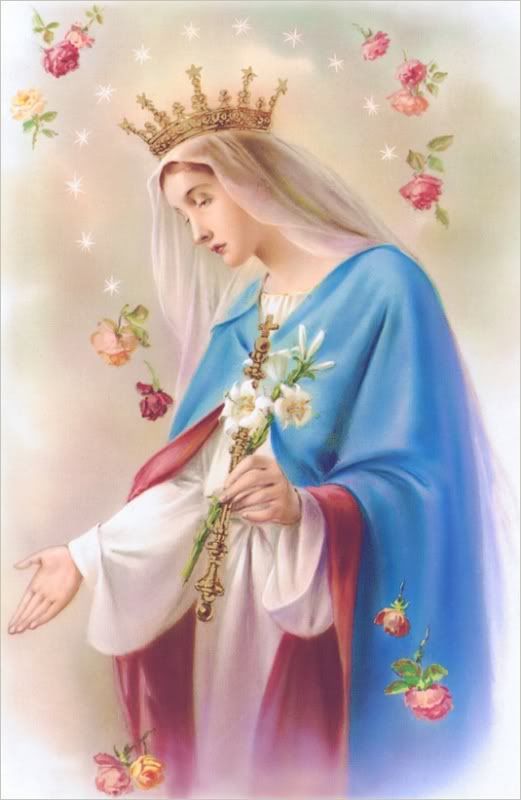
From The Glories Of Mary, by Saint Alphonsus Liguori:
O Immaculate and Holy Virgin! O creature the most humble and the most exalted before God! Thou wast so lowly in thine own eyes, but so great in the eyes of thy Lord, that he exalted thee to such a degree as to choose thee for his Mother, and then made thee Queen of heaven and earth. I therefore thank God who so greatly has exalted thee, and rejoice in seeing thee so closely united with him, that more cannot be granted to a pure creature.
Before thee, who art so humble, though endowed with so precious gifts, I am ashamed to appear, I who am so proud in the midst of so many sins. But miserable as I am, I will also salute thee: Hail, Mary, full of grace. Thou art already full of grace; impart a portion of it to me.
Our Lord is with thee. That Lord who was always with thee from the first moment of thy creation, has now united himself more closely to thee by becoming thy Son.
Blessed art thou amongst women. O Lady, blessed amongst all women, obtain the divine blessing for us also.
And blessed is the fruit of thy womb. O blessed plant which hath given to the world so noble and holy a Fruit!
"Holy Mary, Mother of God!" O Mary, I acknowledge that thou art the true Mother of God, and in defence of this truth I am ready to give my life a thousand times. Pray for us sinners. But if thou art the Mother of God, thou art also the Mother of our salvation, and of us poor sinners; since God became man to save sinners, and made thee his Mother, that thy prayers might have power to save any sinner.
Hasten, then, O Mary, and pray for us, now, and at the hour of our death. Pray always: pray now, that we live in the midst of so many temptations and dangers of losing God; but still more, pray for us at the hour of our death, when we are on the point of leaving this world, and being presented before God's tribunal; that, being saved by the merits of Jesus Christ and by thy intercession, we may come one day, without further danger of being lost; to salute thee and praise thee with thy Son in heaven for all eternity.
Amen.
Labels: Restorationists
Thursday, May 24, 2007
Good Bertie Wooster Talk
Over at Irish Elk.
Just solved my "what-to-read-over-the-holiday-weekend" dilemma. Plum, of course!
Been an age since we last crossed paths!
Just solved my "what-to-read-over-the-holiday-weekend" dilemma. Plum, of course!
Been an age since we last crossed paths!
Library Thing
This is addictive.
I have been hoping to see something like this for years!
Big tip of the silver-laced cocked hat to Father Finigan!
Update:
However, a free membership is limited to just 200 books. Not entirely satisfactory for those of us with libraries numbering in the 1000s.
I have been hoping to see something like this for years!
Big tip of the silver-laced cocked hat to Father Finigan!
Update:
However, a free membership is limited to just 200 books. Not entirely satisfactory for those of us with libraries numbering in the 1000s.
When the Motu Proprio Comes
These are the priests who will be the backbone of the restoration. Good, honest, obedient priests who have done their duty as best as they are able, suffered in silence under obedience to the aging 1960s/70s generation, and about to come into their own.
They remind me of those priests ordained in England before Henry VIII's rebellion, who quietly retained as much as they could despite Henry, Cranmer, and Edward, and came back out of the shadows under Queen Mary.
Let us hope that they fare better in the long run than the English Catholics under Elizabeth.
They remind me of those priests ordained in England before Henry VIII's rebellion, who quietly retained as much as they could despite Henry, Cranmer, and Edward, and came back out of the shadows under Queen Mary.
Let us hope that they fare better in the long run than the English Catholics under Elizabeth.
Labels: Restorationists
Daily Prayer During Our Blessed Lady's Month
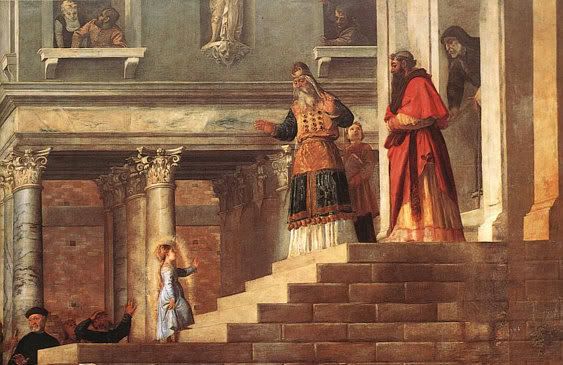
From The Glories Of Mary, by Saint Alphonsus Liguori:
O beloved Mother of God, most amiable child Mary, O that, as thou didst present thyself in the temple, and with promptitude and without reserve, didst consecrate thyself to the glory and love of God, I could offer thee, this day, the first years of my life, to devote myself without reserve to thy service, my holy and most sweet Lady!
But it is now too late to do this; for, unfortunate creature that I am, I have lost so many years in the service of the world and my own caprices, and have lived in almost entire forgetfulness of thee and of God: Woe to that time in which I did not love thee! ("Vae tempori illi, in quo non amavi te!") But it is better to begin late than not at all.
Behold, O Mary, I this day present myself to thee, and I offer myself without reserve to thy service for the long or short time that I still have to live in this world; and in union with thee I renounce all creatures, and devote myself entirely to the love of my Creator. I consecrate my mind to thee, O Queen, that it may always think of the love that thou deservest, my tongue to praise thee, my heart to love thee. Do thou accept, O most holy Virgin, the offering which this miserable sinner now makes thee; accept it, I beseech thee, by the consolation that thy heart experienced when thou gavest thyself to God in the temple.
But since I enter thy service late, it is reasonable that I should redouble my acts of homage and love, thereby to compensate for lost time. Do thou help my weakness with thy powerful intercession, O Mother of Mercy, by obtaining me perseverance from thy Jesus, and strength to be always faithful to thee until death; that thus always serving thee in life, I may praise thee in Paradise for all eternity.
Amen.
Labels: Restorationists
Wednesday, May 23, 2007
Daily Prayer During Our Blessed Lady's Month

From The Glories Of Mary, by Saint Alphonsus Liguori:
O holy and heavenly Infant, Thou who art the destined Mother of my Redeemer and the great mediatrix of miserable sinners, pity me. Behold at thy feet another ungrateful sinner who has recourse to thee and asks thy compassion.
It is true, that for my ingratitude to God and to thee I deserve that God and thou shouldst abandon me. But I have heard, and believe it to be so (knowing the greatness of thy mercy), that thou dost not refuse to help any one who recommends himself to thee with confidence.
O most exalted creature in the world! Since this is the case, and since there is no one but God above thee, so that compared with thee the greatest saints of heaven are little; O saint of saints, O Mary! abyss of charity, and full of grace, succor a miserable creature who by his own fault has lost the divine favor.
I know that thou art so dear to God that he denies thee nothing. I know also that thy pleasure is to use thy greatness for the relief of miserable sinners. Then, show how great is the favor that thou enjoyest with God, by obtaining me a divine light and flame so powerful that I may be changed from a sinner into a saint; and detaching myself from every earthly affection, divine love may be enkindled in me. Do this, O Lady, for thou canst do it. Do it for the love of God, Who has made thee so great, so powerful, and so compassionate. This is my hope.
Amen.
Labels: Restorationists
Tuesday, May 22, 2007
Daily Prayer During Our Blessed Lady's Month

From The Glories Of Mary, by Saint Alphonsus Liguori:
O, my Immaculate Lady! I rejoice with thee on seeing thee enriched with so great purity. I thank, and, resolve always to thank, our common Creator for having preserved thee from every stain of sin; and I firmly believe this doctrine, and am prepared and swear even to lay down my life, should this be necessary, in defence of this thy so great and singular privilege of being conceived immaculate.
I would that the whole world knew thee and acknowledged thee as being that beautiful "Dawn" which was always illumined with divine light; as that chosen "Ark" of salvation, free from the common shipwreck of sin; that perfect and immaculate "Dove" which thy divine Spouse declared thee to be; that "enclosed Garden" which was the delight of God; that "sealed Fountain" whose waters were never troubled by an enemy; and finally, as that "white Lily," which thou art, and who, though born in the midst of the thorns of the children of Adam, all of whom are conceived in sin, and the enemies of God, wast alone conceived pure and spotless, and in all things the beloved of thy Creator.
Permit me, then, to praise thee also as thy God himself has praised thee: Thou art all fair, and there is not a spot in thee ("Tota pulchra es, Amica mea, et macula non est in te" Cant. iv. 7). O most pure Dove, all fair, all beautiful, always the friend of God. O how beautiful art thou, my beloved! How beautiful art thou! ("Quam pulchra es, amica mea, quam pulchra es!" Ib. 1).
Most sweet, most amiable, immaculate Mary, thou who art so beautiful in the eyes of thy Lord, disdain not to cast thy compassionate eyes on the wounds of my soul, loathsome as they are. Behold me, pity me, heal me.
O beautiful loadstone of hearts, draw also my miserable heart to thyself.
O thou, who from the first moment of thy life didst appear pure and beautiful before God, pity me, who not only was born in sin, but have again since baptism stained my soul with crimes.
What grace will God ever refuse thee, who chose thee for his daughter, his Mother, and Spouse, and therefore preserved thee from every stain, and in his love preferred thee to all other creatures? I will say, in the words of St. Philip Neri, "Immaculate Virgin, thou hast to save me."
Grant that I may always remember thee; and thou, do thou never forget me. The happy day, when I shall go to behold thy beauty in Paradise, seems a thousand years off; so much do I long to praise and love thee more than I can now do, my Mother, my Queen, my beloved, most beautiful, most sweet, most pure, Immaculate Mary.
Amen.
Labels: Restorationists
Monday, May 21, 2007
Into Great Silence
Finally saw it this weekend.
I think I can safely say that this movie is the last word on monastic simplicity.
So many images just crowd the mind two days after seeing the movie.
First, what we don't see is spiritual combat. In fact, it is only obliquely referred to. The film opens with two postulants entering the community, one black and one Asian. About midway through the movie, while the monks are taking a walk, one asks, "When are you flying," and then, "Where are you flying to?". The response is "Seoul." And since the Asian postulant disappears from the rest of the film, I think we are to take it that he has washed out, and has gone home. As the Abbot says when the two are being accepted into the community, the life of a Carthusian monk is not for everyone.
What we do see and hear is the simplest of images. An elderly lay brother lovingly and with enormous difficulty shoveling the snow from three small garden plots (so small I was wondering if they were graves), fingering seed packets, then, later, in the summer woods picking herbs (for Chartreuse?).
We hear bells. Bells summoning the brothers to Matins and Mass. Bells summoning them to work, or to begin the office. Bells summoning them to meals. But the pattern of the bells is not explained (nothing is, actually). If you want to know why the bells are being rung, you have to study the patterns of Carthusian monastic life.
We see monks sawing or chopping wood, cutting fabric for robes, preparing meals, all slowly, with love and care. The movie focuses on little things, and that is an understatement. We see in the "tailor" workshop a box full of white buttons. Then, later in the film, the camera picks up a white button sewn fairly high onto the sleeve of one of the brothers. You ask why is there a button there, but there is no answer, unless I missed it.
Natural sounds. The calls of birds. The patter of rain. The rustle of leaves. The fall of snow. The melting of ice. The viewer will have a better understanding of the seasonal pattern than of the pattern of the monastic day.
The sounds of work. A metal bowl balanced on its rim, rocking to and fro after being set down. Wood being sawed. Scissors cutting wool. Gluing and hammering the sole of a boot. Celery being chopped. The electric clippers as hair is being shaved (sorry, no true tonsures!).
The sounds of prayer. The bells. Prayers in French for a new member of the community recited in his cell. The chant of the Office, in Latin. I could not tell whether the monks were using the old office or the new. I assume the new, just chanted in Latin. But perhaps and expert could spot the difference where I cannot.
We see a life of contemplation, work, and prayer lived very simply. A recurring theme is the daily delivery of food to the cells. We see a little door in the door of the cell unlocked, and bread and fruit and water, and bottles of what looks like wine being passed through. The Carthusians, unlike Benedictines, etc., do not eat in community, except on Sundays and feasts. In fact, aside from Mass and Matins, they do very little in community. They live as hermits, each doing his own work, praying the Office in solitude.
Technology? Almost none. A life without television, radio, CDs, iPods, MP3 players, cell phones, computers (though I thought I saw a keyboard on Father Abbot's desk, half-buried under paper, as he looked over the bills). Almost the most "up-to-date" tool I saw was a big new-looking hand-saw.
A life largely without contact with the outside world. There must be visitors to the Grand Chartreuse. In one late scene, we briefly see back-packed young people, who I suppose were there for a retreat. But the movie leaves the impression that this is not a common occurrence.
If you are looking for a lot of Catholic ceremonial and imagery, you will be disappointed. There is the odd statue here and there. The desk of one of the monks has some images of saints stuck along the edges (I picked out St. Therese of Lisieux). There is a nice, if dusty, Calvary group atop the Rood Screen in their oratory. We see much of the chanting of Matins, but no daytime offices (since they pray these alone). We see Mass once. We see Eucharistic Adoration once. We see the Blessed Sacrament being carried to what must be an altar of repose on Maundy Thursday (as the monks are chanting the Pange Lingua: and there we see double thurifers loaded with incense unloosed in a narrow corridor). It seemed to be daylight when this procession was happening, so I was a little puzzled. It might have been a Corpus Christi procession, now that I think about it.
That is about it for ceremonial and images. The monks' lives are simple, and so is their mode of worship.
I would recommend learning something about the basics of the monastic day before watching the film. That will enable you to put things in context.
The producer keeps coming back to two quotations. "Unless you give up all that you have, you cannot become my disciple." Modern notions of monastic poverty have been modified since the 19th century. Now Benedictines and other monks are often allowed to retain some of their own clothes, books, bring a cat or dog with them, even have a computer. Not so the Carthusians. You are in a very plain cell almost all day. You chop wood to burn to keep warm. You have a few books, probably borrowed from the community library (though we don't visit that). I did note that street clothes were worn under the robes (shirt collars were visible), but these might be communally owned. Certainly, the Carthusians are closer to the monastic ideal of poverty and simplicity than others are today. They have truly given up all, and entered the desert, like the monks of Scete.
The other quotation the producer uses often is "O Lord, you seduced me, and I was seduced." You get the impression that these men have embraced this very simple form of life, that they find joy in it. There is the knowing smile on the face of the elderly lay brother as he shovels the snow from his beloved garden patches, and gathers herbs. We see the brothers out on a walk in the winter, sliding down a snow-covered hill with child-like joy. We hear them speak to each other only once, on a Sunday spring-time walk. And the conversation is what apparently delights them. One tells another that what was read at refectory is usually omitted as being a later addition. So, on the rare occasions they can speak, the talk is not of soccer scores, but exegetical accounts of what ought be be considered a footnote in the Rule. That is the sort of conversation that delights them. We see brothers looking into the camera quite a lot. Most hold the pose reasonably well, until their discomfort got the better of them. But one brother in early middle age just can't help himself. He looks and looks, and tries to stay stoic, but eventually relaxes into an impish grin. He is telling us in his smile that there is happiness and joy, and love here.
If you wanted to find out how Chartreuse is made, see another documentary. The process is not even alluded to. If you want to know how the monastic day is carried out, see another documentary. The story line is far too disjointed for you to make sense of it. If you want to learn about the history of Catholic spirituality, from Terese of Avila to John of the Cross, see another documentary. No mention of this at all. But if you want a study in simplicity, where reverent silence permeates the life, and combines with the natural pattern of the seasons, see Into Great Silence.
I think I can safely say that this movie is the last word on monastic simplicity.
So many images just crowd the mind two days after seeing the movie.
First, what we don't see is spiritual combat. In fact, it is only obliquely referred to. The film opens with two postulants entering the community, one black and one Asian. About midway through the movie, while the monks are taking a walk, one asks, "When are you flying," and then, "Where are you flying to?". The response is "Seoul." And since the Asian postulant disappears from the rest of the film, I think we are to take it that he has washed out, and has gone home. As the Abbot says when the two are being accepted into the community, the life of a Carthusian monk is not for everyone.
What we do see and hear is the simplest of images. An elderly lay brother lovingly and with enormous difficulty shoveling the snow from three small garden plots (so small I was wondering if they were graves), fingering seed packets, then, later, in the summer woods picking herbs (for Chartreuse?).
We hear bells. Bells summoning the brothers to Matins and Mass. Bells summoning them to work, or to begin the office. Bells summoning them to meals. But the pattern of the bells is not explained (nothing is, actually). If you want to know why the bells are being rung, you have to study the patterns of Carthusian monastic life.
We see monks sawing or chopping wood, cutting fabric for robes, preparing meals, all slowly, with love and care. The movie focuses on little things, and that is an understatement. We see in the "tailor" workshop a box full of white buttons. Then, later in the film, the camera picks up a white button sewn fairly high onto the sleeve of one of the brothers. You ask why is there a button there, but there is no answer, unless I missed it.
Natural sounds. The calls of birds. The patter of rain. The rustle of leaves. The fall of snow. The melting of ice. The viewer will have a better understanding of the seasonal pattern than of the pattern of the monastic day.
The sounds of work. A metal bowl balanced on its rim, rocking to and fro after being set down. Wood being sawed. Scissors cutting wool. Gluing and hammering the sole of a boot. Celery being chopped. The electric clippers as hair is being shaved (sorry, no true tonsures!).
The sounds of prayer. The bells. Prayers in French for a new member of the community recited in his cell. The chant of the Office, in Latin. I could not tell whether the monks were using the old office or the new. I assume the new, just chanted in Latin. But perhaps and expert could spot the difference where I cannot.
We see a life of contemplation, work, and prayer lived very simply. A recurring theme is the daily delivery of food to the cells. We see a little door in the door of the cell unlocked, and bread and fruit and water, and bottles of what looks like wine being passed through. The Carthusians, unlike Benedictines, etc., do not eat in community, except on Sundays and feasts. In fact, aside from Mass and Matins, they do very little in community. They live as hermits, each doing his own work, praying the Office in solitude.
Technology? Almost none. A life without television, radio, CDs, iPods, MP3 players, cell phones, computers (though I thought I saw a keyboard on Father Abbot's desk, half-buried under paper, as he looked over the bills). Almost the most "up-to-date" tool I saw was a big new-looking hand-saw.
A life largely without contact with the outside world. There must be visitors to the Grand Chartreuse. In one late scene, we briefly see back-packed young people, who I suppose were there for a retreat. But the movie leaves the impression that this is not a common occurrence.
If you are looking for a lot of Catholic ceremonial and imagery, you will be disappointed. There is the odd statue here and there. The desk of one of the monks has some images of saints stuck along the edges (I picked out St. Therese of Lisieux). There is a nice, if dusty, Calvary group atop the Rood Screen in their oratory. We see much of the chanting of Matins, but no daytime offices (since they pray these alone). We see Mass once. We see Eucharistic Adoration once. We see the Blessed Sacrament being carried to what must be an altar of repose on Maundy Thursday (as the monks are chanting the Pange Lingua: and there we see double thurifers loaded with incense unloosed in a narrow corridor). It seemed to be daylight when this procession was happening, so I was a little puzzled. It might have been a Corpus Christi procession, now that I think about it.
That is about it for ceremonial and images. The monks' lives are simple, and so is their mode of worship.
I would recommend learning something about the basics of the monastic day before watching the film. That will enable you to put things in context.
The producer keeps coming back to two quotations. "Unless you give up all that you have, you cannot become my disciple." Modern notions of monastic poverty have been modified since the 19th century. Now Benedictines and other monks are often allowed to retain some of their own clothes, books, bring a cat or dog with them, even have a computer. Not so the Carthusians. You are in a very plain cell almost all day. You chop wood to burn to keep warm. You have a few books, probably borrowed from the community library (though we don't visit that). I did note that street clothes were worn under the robes (shirt collars were visible), but these might be communally owned. Certainly, the Carthusians are closer to the monastic ideal of poverty and simplicity than others are today. They have truly given up all, and entered the desert, like the monks of Scete.
The other quotation the producer uses often is "O Lord, you seduced me, and I was seduced." You get the impression that these men have embraced this very simple form of life, that they find joy in it. There is the knowing smile on the face of the elderly lay brother as he shovels the snow from his beloved garden patches, and gathers herbs. We see the brothers out on a walk in the winter, sliding down a snow-covered hill with child-like joy. We hear them speak to each other only once, on a Sunday spring-time walk. And the conversation is what apparently delights them. One tells another that what was read at refectory is usually omitted as being a later addition. So, on the rare occasions they can speak, the talk is not of soccer scores, but exegetical accounts of what ought be be considered a footnote in the Rule. That is the sort of conversation that delights them. We see brothers looking into the camera quite a lot. Most hold the pose reasonably well, until their discomfort got the better of them. But one brother in early middle age just can't help himself. He looks and looks, and tries to stay stoic, but eventually relaxes into an impish grin. He is telling us in his smile that there is happiness and joy, and love here.
If you wanted to find out how Chartreuse is made, see another documentary. The process is not even alluded to. If you want to know how the monastic day is carried out, see another documentary. The story line is far too disjointed for you to make sense of it. If you want to learn about the history of Catholic spirituality, from Terese of Avila to John of the Cross, see another documentary. No mention of this at all. But if you want a study in simplicity, where reverent silence permeates the life, and combines with the natural pattern of the seasons, see Into Great Silence.
Labels: Restorationists
Daily Prayer During Our Blessed Lady's Month

From The Glories Of Mary, by Saint Alphonsus Liguori:
O Mother of mercy, since thou art so compassionate, and hast so great a desire to render service to us poor creatures and to grant our requests, behold I, the most miserable of all men, have now recourse to thy compassion, in order that thou mayest grant me that which I ask. Others may ask what they please of thee,—bodily health, and earthly goods and advantages; but I come, O Lady, to ask thee for that which thou desired of me humility and love of contempt.
Thou wast so patient under the sufferings of this life; obtain for me patience in trials.
Thou wast all filled with the love of God; obtain for me the gift of his pure and holy love.
Thou wast all love towards thy neighbor; obtain for me charity towards all, and particularly towards those who are in any way my enemies.
Thou wast entirely united to the divine will; obtain for me entire conformity to the will of God in whatever way he may be pleased to dispose of me.
Thou, in fine, art the most holy of all creatures; O Mary, make me a saint.
Love for me is not wanting on thy part; thou canst do all, and thou hast the will to obtain me all.
The only thing, then, that can prevent me from receiving thy graces is, either neglect on my part in having recourse to thee, or little confidence in thy intercession; but these two things thou must obtain for me. These two greatest graces I ask from thee; from thee I must obtain them; from thee I hope for them with the greatest confidence, O Mary, my Mother Mary, my hope, my love, my life, my refuge, my help, and my consolation.
Amen.
Labels: Restorationists
Sunday, May 20, 2007
Daily Prayer During Our Blessed Lady's Month

From The Glories Of Mary, by Saint Alphonsus Liguori:
O Queen of heaven, Mother of holy love! since thou art the most amiable of creatures, the most beloved of God, and his greatest lover, be pleased to allow the most miserable sinner living in this world, who, having by thy means been delivered from hell, and without any merit on his part been so benefited by thee and who is filled with love for thee, to love thee.
I would desire, were it in my power, to let all men who know thee not know how worthy thou art of love, that all might love and honor thee. I would desire to die for the love of thee, in defence of thy virginity, of thy dignity of Mother of God, of thy Immaculate Conception, should this be necessary, to uphold these thy great privileges. O my most beloved Mother, accept this my ardent desire, and never allow a servant of thine, who loves thee, to become the enemy of thy God, whom thou lovest so much.
Alas! poor me, I was so for a time, when I offended my Lord. But then, O Mary, I loved thee but little, and strove but little to be beloved by thee. But now there is nothing that I so much desire, after the grace of God, as to love and be loved by thee. I am not discouraged on account of my past sins, for I know that thou, O most benign and gracious Lady, dost not disdain to love even the most wretched sinners who love thee; nay more, that thou never allowest thyself to be surpassed by any in love.
Queen most worthy of love, I desire to love thee in heaven. There, at thy feet, I shall better know how worthy thou art of love, how much thou hast done to save me; and thus I shall love thee with greater love, and love thee eternally, without fear of ever ceasing to love thee.
O Mary, I hope most certainly to be saved by thy means. Pray to Jesus for me. Nothing else is needed; thou hast to save me; thou art my hope. I will therefore always sing O Mary, my hope, thou hast to save me.
Amen.
Labels: Restorationists



